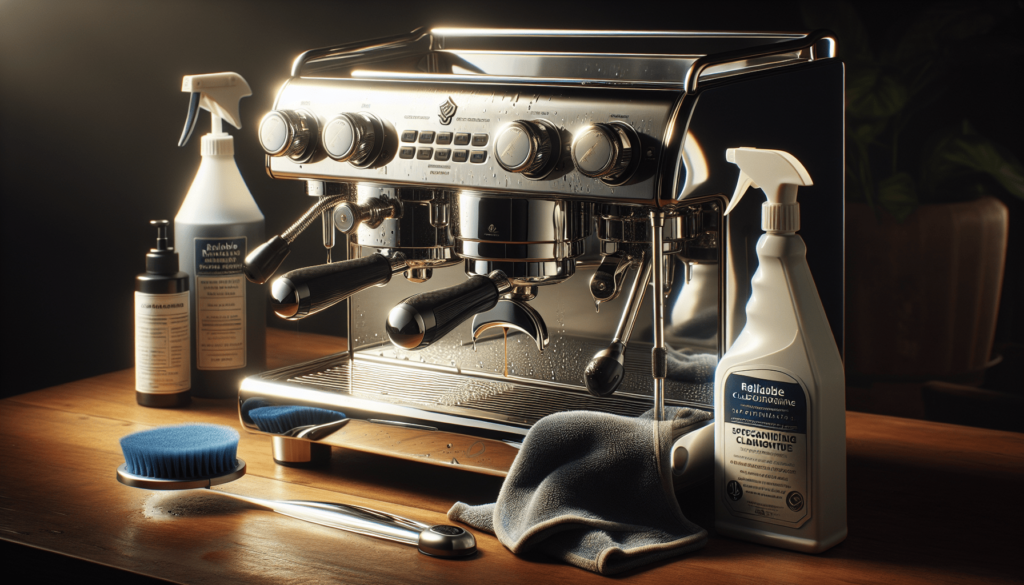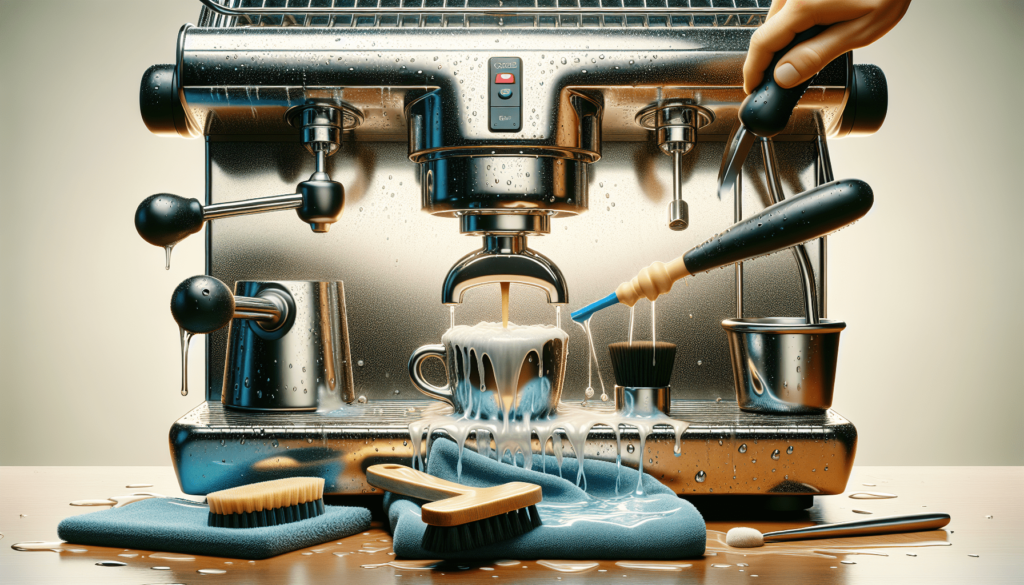If you’re a coffee enthusiast who relies on your trusty espresso machine to brew the perfect cup of java every morning, then it’s essential to know how to properly clean and care for your beloved appliance. Maintaining the cleanliness of your espresso machine not only ensures that it continues to produce high-quality coffee, but it also extends its lifespan. From regular descaling to daily wipe downs, this article will guide you through the necessary steps to keep your espresso machine in optimal condition. So grab your cleaning supplies and let’s get started!

Regular Cleaning
Daily Cleaning
Maintaining a regular cleaning routine for your espresso machine is essential to keep it in optimal condition. One of the most important aspects of regular cleaning is daily maintenance. After each use, you should wipe the exterior of the machine with a damp cloth to remove any coffee residue or spills. This will help prevent stains and keep your machine looking pristine.
Weekly Cleaning
In addition to daily cleaning, it’s important to perform a more thorough cleaning at least once a week. This ensures that any buildup or deposits are removed from the internal components of the machine. Weekly cleaning involves descaling the machine, cleaning the portafilter, steam wand, water reservoir, drip tray, group head, and grinder.
Descale the Machine
Why Descaling is Important
Descaling is a crucial step in maintaining your espresso machine’s performance and longevity. Over time, mineral deposits from the water can accumulate on the internal components, particularly the heating element and water lines. This buildup can affect the temperature and flow of water, resulting in poor extraction and potential damage to the machine.
How Often to Descale
The frequency of descaling depends on various factors such as the hardness of your water and the frequency of use. As a general guideline, it is recommended to descale your espresso machine every three to four months. However, if you notice a decrease in performance or if your water is particularly hard, more frequent descaling may be necessary.
Steps to Descale
To descale your espresso machine, you will need a descaling solution specifically designed for coffee machines. Follow the instructions provided by the manufacturer of the solution, as different brands may have slightly different procedures. Generally, you will need to mix the descaling solution with water and run it through the machine’s brewing cycle. This will remove any mineral deposits and leave your machine clean and ready for use.
Cleaning the Portafilter
Removing Coffee Grounds
After each use, it is important to remove the coffee grounds from the portafilter. Start by knocking the portafilter gently on a knock box or a towel to remove any loose grounds. Then, use a small brush or your finger to sweep away any remaining residue. Make sure to clean around the edges of the basket to ensure a clean and consistent extraction.
Soaking in Hot Water
Periodically, it is beneficial to soak the portafilter in hot water to remove any oils or residue that may have accumulated. Fill a container with hot water and submerge the portafilter for about 10-15 minutes. This will help break down any stubborn stains or build up. After soaking, rinse the portafilter thoroughly with clean water.
Brushing the Screen
The screen inside the portafilter is responsible for distributing the water evenly over the coffee grounds during the brewing process. Over time, this screen can become clogged with oils and coffee particles, affecting the extraction and taste of your espresso. To clean the screen, use a small brush or a toothbrush to gently scrub away any debris. Be careful not to damage the screen while cleaning.
Cleaning the Steam Wand
Wiping After Each Use
The steam wand is an essential component of an espresso machine, used to froth milk for cappuccinos and lattes. After each use, it is important to wipe the steam wand with a damp cloth to remove any milk residue. Leaving milk to dry on the steam wand can lead to clogs and affect the quality of your steamed milk.
Soaking in Milk Cleaner
To thoroughly clean the steam wand, it is recommended to periodically soak it in a milk cleaner solution. Mix the milk cleaner according to the instructions provided and submerge the steam wand in the solution for the recommended time. This will help dissolve any milk residue and ensure the wand is hygienically clean.
Using a Steam Wand Brush
To remove any stubborn residue or buildup on the steam wand, use a steam wand brush. These brushes are specifically designed to reach the nooks and crannies of the wand and effectively remove any remaining milk residue. Gently scrub the wand with the brush, being careful not to scratch the surface.

Cleaning the Water Reservoir
Emptying and Rinsing
Periodically, you should empty and rinse the water reservoir of your espresso machine. This helps prevent the accumulation of any impurities or bacteria that may have been introduced through the water. Simply remove the reservoir from the machine, empty any remaining water, and rinse it thoroughly with clean water.
Using Vinegar Solution
To remove any mineral deposits or stubborn stains from the water reservoir, you can use a vinegar solution. Mix equal parts of vinegar and water and fill the reservoir. Let it sit for a few minutes to allow the vinegar to break down any deposits, then empty the reservoir and rinse thoroughly with clean water. Be sure to rinse multiple times to remove any vinegar residue.
Cleaning the Drip Tray
Removing and Emptying
The drip tray catches any drips or spills that occur during the brewing process. It is important to remove and empty the drip tray regularly to prevent bacteria growth and odors. Lift the drip tray carefully, ensuring not to spill any liquid, and empty it into the sink.
Washing with Warm Soapy Water
To clean the drip tray effectively, you can wash it with warm soapy water. Use a gentle dish soap and a sponge or cloth to scrub away any residue. Rinse the drip tray thoroughly with clean water and dry it before placing it back into the machine. This will help keep the drip tray hygienically clean and avoid any unpleasant odors.
Cleaning the Group Head
Brushing the Shower Screen
The shower screen, located inside the group head, is responsible for evenly distributing water over the coffee grounds during extraction. Over time, this screen can become clogged with coffee oils and particles, affecting the quality of your espresso. To clean the shower screen, use a small brush or a toothbrush to gently scrub away any debris. Be careful not to damage the screen during cleaning.
Backflushing with Cleaner
Backflushing is a method used to clean the group head and internal components of an espresso machine. It involves using a backflush disc or blind filter basket and a cleaning agent specifically designed for espresso machines. Follow the instructions provided with the cleaning agent to backflush your machine effectively. This process helps remove any buildup and ensures a clean and well-functioning group head.
Cleaning the Grinder
Removing Coffee Bean Residue
If your espresso machine has a built-in grinder, it is important to clean it regularly to prevent the buildup of coffee bean residue. After each use, remove any remaining coffee beans from the hopper and discard. Then, using a grinder brush, gently clean the burrs and surrounding areas to remove any residual coffee grounds.
Using a Grinder Brush
A grinder brush is a small tool specifically designed to clean coffee grinders. It consists of bristles that effectively remove coffee grounds from the burrs and other hard-to-reach areas. Simply run the grinder brush along the burrs and surfaces of the grinder to dislodge any trapped particles. This will help maintain the quality of your coffee and extend the lifespan of your grinder.
Maintaining the Gaskets
Checking for Wear and Tear
Gaskets are rubber seals that are used in various parts of an espresso machine to create a watertight seal. Over time, these gaskets may wear out or become damaged, leading to leaks or decreased performance. Regularly inspect the gaskets on your machine to ensure they are in good condition. Look for any signs of wear, cracking, or deformation. If you notice any issues, it is advisable to replace the gaskets promptly.
Replacing Worn Gaskets
If you find that the gaskets on your espresso machine are worn or damaged, it is important to replace them as soon as possible. Contact the manufacturer or a reputable service provider to obtain the correct replacement gaskets for your machine. Follow the manufacturer’s instructions or seek professional assistance to ensure proper installation and functionality.
Tips for Proper Care
Using High-Quality Water
The quality of water used in your espresso machine can greatly impact its performance and lifespan. Using high-quality water, such as filtered or bottled water, can help reduce the mineral content and prevent the accumulation of scale and deposits. Avoid using tap water or distilled water, as they may either contain too many minerals or lack essential minerals for optimal extraction.
Storing Your Machine Properly
When not in use, it is important to store your espresso machine properly to prevent dust accumulation and potential damage. Ensure that the machine is turned off and unplugged before cleaning and storing. Store it in a clean and dry area, away from direct sunlight or excessive heat. Additionally, cover the machine with a dust cover or cloth to protect it from dust and debris.
Regularly Servicing Your Machine
To keep your espresso machine in top condition, it is recommended to have it professionally serviced at regular intervals. A professional technician will be able to inspect and clean internal components that may not be accessible during regular cleaning. They can also identify any potential issues or parts that require replacement. Regular servicing will help prolong the lifespan of your machine and ensure its optimal performance.
Remember, maintaining a clean and well-cared-for espresso machine will not only result in better-tasting coffee but also prolong the lifespan of your investment. By following these cleaning and care tips, you can enjoy delicious espresso for years to come. Happy brewing!

